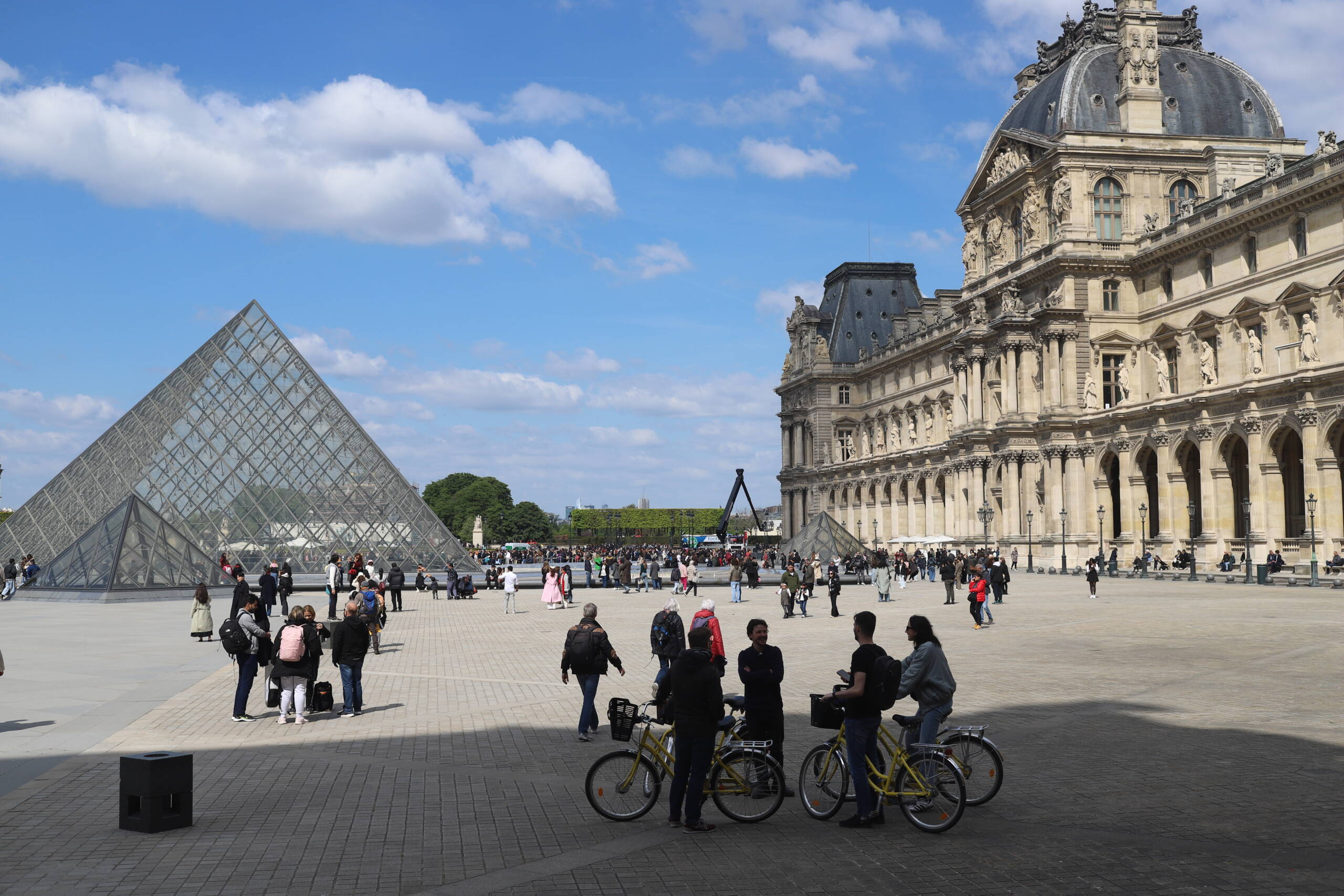The courtyard outside the Louvre looks almost too calm for the kind of worry it now carries. In the image, the iconic glass pyramid stands gleaming under a bright blue sky, its angles cutting sharply against the soft drifts of cloud. Tourists scatter the plaza in quiet constellations — some strolling, some waiting in loose, patient lines, others pausing beside yellow rental bicycles mid-conversation, as if Paris always arranges itself into a scene that could be painted. To the right, the immense palace façade rises in ornate stone, sculpted figures frozen in their permanent watch. And there, further back — almost easy to overlook — a dark triangular lift sits near the center of the courtyard. It looks like standard maintenance equipment, the kind of thing you’d usually ignore without thought. But now, after the recent robbery, it has taken on a different tone. It resembles the same type of lift used in the heist, and suddenly it feels like a clue left in plain sight, or maybe more accurately, a reminder of how the ordinary can shift into something dangerous when intention changes.

Shot with Canon EOS R6 Mark III and RF45mm F1.2 STM
The news has settled like a thin layer of dust on marble floors: the robbery has shaken the museum world in a way that feels both surreal and somehow inevitable. You don’t expect thieves to stroll into the world’s most visited museum and walk out with something priceless, and yet here we are. Directors are calling emergency meetings; curators are pacing their offices. Even the quiet guard, the one who stands still for hours beneath vaulted ceilings, is likely replaying the possibility of what they could have missed. The Louvre isn’t just a museum — it’s a symbol of what humanity wants to remember about itself. To see it breached is to feel something foundational flicker.
And the anxiety is spreading. Museums everywhere are now interrogating their own assumptions. For years, security has been a choreography of cameras, badges, and sensors — precise, rehearsed, confident. But any system observed long enough becomes predictable. This is the challenge of museums: they must remain open. They must welcome strangers, day after day, millions of them. Art wants to be seen. The act of protecting art and the act of sharing it are always in quiet conflict, and that conflict is now sharper, harder-edged, no longer theoretical. It’s the sort of problem that keeps people awake long after everyone else has gone home.
And this has reminded us of something almost uncomfortable: our relationship with cultural heritage is fragile. We assume the paintings and sculptures we love will always be there when we’re finally ready to visit them. We forget that their survival is not inevitable but actively maintained, daily — through care, surveillance, funding, and yes, vigilance. A painting can endure five centuries and still vanish in five minutes. Beauty is not guaranteed; it is constantly defended.
So museums are beginning to shift. Some are leaning into barriers, controlled distances, thicker glass. Others are moving toward invisible guardians: AI systems that analyze patterns of movement, biometric signals that read intent, microchips embedded deep in the grain of canvases, giving each artwork a kind of silent pulse. The future museum may look the same on the surface but will hum with hidden awareness beneath it. The danger is that museums could feel less like sanctuaries of art and more like laboratories crossed with airports. Beauty observed, yes — but also continuously monitored.
Yet the courtyard in the photograph remains full of life. People talking, laughing, leaning on bicycles, drifting toward the pyramid with that gentle tourism curiosity. The sky is bright. The day feels open. And maybe that’s the most important tension: the world continues, and the art is still there, waiting, vulnerable but present.
Maybe the worry isn’t entirely something to fear. Perhaps it sharpens our sense of value. When we recognize that something can be taken, we remember how deeply we want it to stay.
Leave a Reply